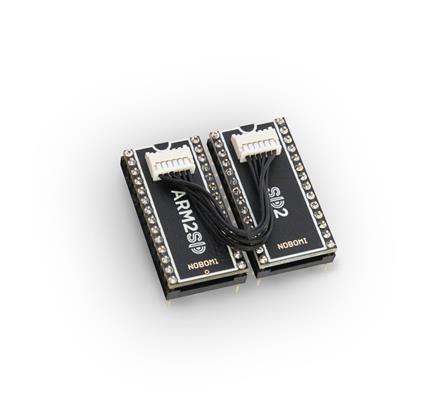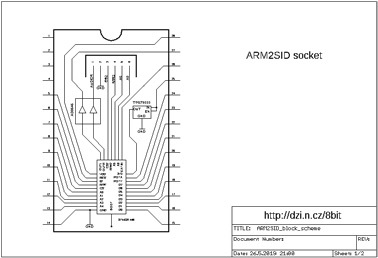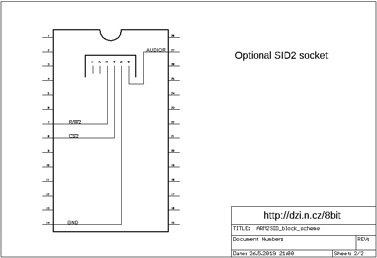Ich bin auch interessiert und wurde dich Anschreiben.![]()
Beiträge von Probe
-
-
Ich bitte auch, Weiss nicht was sie kosten aber ich koennte 2 brauchen
 , mindestens eins.
, mindestens eins. -
Danke Frenetic und Bubblebobble , Ich habe ein Angebot bekommen.
-
Had jemand vielleicht noch eine ferigmontierte SIDKick shortboard version fuer mich?
-
Danke, auch für die verbesserte Ordner struktur.
-
Brilliant stuff, thinking outside the box. Mind blown.
-
Yes please
-
Hey, Probe, thank you for the ROM file. Unfortunately, I'm pretty sure it is not SpeedDos, but a hack. Why? The SpeedDos manual describes function keys, and at least with a couple of quick tests (under Vice) using 64'er Floppy-Speed-Test it showed 6x performance with and without parallel cable.
Indeed, verified hack from Armageddon or Peace kernal ROM.
-
Kernal ROM attached comes from TOSEC. Seems to be v1.0 SpeedDOS. It works with 1541XX drives. The function keys are not present in this version but loading is faster with parallel cable enabled. I'm not sure if this was the case when the first SpeedDOS came out.
-
Awesome job, thank you Zipcom.
-
He's also on Amibay, I asked him for some more details a while ago, examples(lazy jones), video demo maybe, very few where given. He understands english so I take it it's the old version with a few tweaks here and there.
"Yes Lazy and based on Swinsid
Hardware revisited and optimized for less audio distortion and also for a new layout" -
I like a lot of tunes ,indeed, like the rest, it's hard to pick favorites so I give you my most played. (Which also changes
 ). Also I can't count
). Also I can't countElektro Klacz - Jammer
Al-risah - Jammer
Hawkeye- Jeroen Tel
Driller - Matt Gray
Dexion ranking demo - Future Freak
Shadowfire - Fred Gray
Hyperion 2 - Matt Gray
2 SID
Fast Lane - Owen Crowley
Blank Page - Owen Crowley
Blank Page part III - Owen Crowley
Experiment five - Owen Crowley
-
V1.1 (ocean format) cartridge added!
Zeta Wing (C64) » Devlog
1 day ago by SarahJaneAvory (@SarahJaneAvory)Share this post:
I've added an Ocean format cartridge image so it should work with EasyFlash3.
Save works also
Files
ZetaWing v1.1 (ocean).crt128 kB
1 day ago -
aforementioned x2008 demo, ViciousSID. Interesting to watch in JSIDPLAY2 with SID oscilloscope on to watch the effect.
-
In the beginning when a sample played nothing else played. I guess that explains some. Later on they developed other ways for playing samples. Also the 6581 8580 differed in handling the samples. Not everything is crystal clear to me but they hacked the shit out of SID

ref:https://en.wikipedia.org/wiki/MOS_Technology_6581
~
The SID is a mixed-signal integrated circuit, featuring both digital and analog circuitry. All control ports are digital, while the output ports are analog. The SID features three-voice synthesis, where each voice may use one of at least five different waveforms: pulse wave (with variable duty cycle), triangle wave, sawtooth wave, pseudorandom noise (called white noise in documentation), and certain complex/combined waveforms when multiple waveforms are selected simultaneously. A voice playing Triangle waveform may be ring-modulated with one of the other voices, where the triangle waveform's bits are inverted when the modulating voice's msb is set, producing a discontinuity and change of direction with the Triangle's ramp. Oscillators may also be hard-synced to each other, where the synced oscillator is reset whenever the syncing oscillator's msb raises.
Each voice may be routed into a common, digitally controlled analog 12 dB/octave multimode filter, which is constructed with aid of external capacitors to the chip. The filter has lowpass, bandpass and highpass outputs, which can be individually selected for final output amplification via master volume register. Using a combined state of lowpass and highpass results in a notch (or inverted bandpass) output.[7] The programmer may vary the filter's cut-off frequency and resonance. An external audio-in port enables external audio to be passed through the filter.
The ring modulation, filter, and programming techniques such as arpeggio (rapid cycling between frequencies to make chord-like sounds) together produce the characteristic feel of SID music.
Due to imperfect manufacturing technologies of the time and poor separation between the analog and digital parts of the chip, the 6581's output (before the amplifier stage) was always slightly biased from the zero level. Each time the volume register was altered, an audible click was produced. By quickly adjusting the amplifier's gain through the main 4-bit volume register, this bias could be modulated as PCM, resulting in a "virtual" fourth channel allowing 4-bit digital sample playback. The glitch was known and used from an early point on, first by Electronic Speech Systems to produce sampled speech in games such as Impossible Mission (1983, Epyx) and Ghostbusters (1984, Activision). The first instance of samples being used in actual musical compositions was by Martin Galway in Arkanoid (1987, Imagine), although he had copied the idea from an earlier drum synthesizer package called Digidrums. The length of sampled sound playback was limited first by memory and later technique. Kung Fu Fighting (1986), a popular early sample, has a playback length measured in seconds. c64mp3 (2010) and Cubase64 (2010) demonstrate playback lengths measured in minutes. Also, it was hugely CPU intensive - one had to output the samples very fast (in comparison to the speed of the 6510 CPU).
The better manufacturing technology in the 8580 used in the later revisions of Commodore 64C and the Commodore 128DCR caused the bias to almost entirely disappear, causing the digitized sound samples to become very quiet. Fortunately, the volume level could be mostly restored with either a hardware modification (biasing the audio-in pin), or more commonly a software trick involving using the Pulse waveform to intentionally recreate the required bias. The software trick generally renders one voice temporarily unusable, although clever musical compositions can make this problem less noticeable. An excellent example of this quality improvement noticeably reducing a sampled channel can be found in the introduction to Electronic Arts' game Skate or Die (1987). The guitar riff played is all but missing when played on the Commodore 64c or the Commodore 128.
At the X'2008 demo party, a completely new method of playing digitized samples was unveiled. The method allows for an unprecedented four (software-mixed) channels of 8-bit samples with optional filtering on top of all samples, as well as two ordinary SID sound channels.[8][9] The method works by resetting the oscillator using the waveform generator test bit, quickly ramping up the new waveform with the Triangle waveform selected, and then disabling all waveforms, resulting in the DAC continuing to output the last value---which is the desired sample. This continues for as long as two scanlines, which is ample time for glitch-free, arbitrary sample output. It is however more CPU-intensive than the 4-bit volume register DAC trick described above. Because the filtering in a SID chip is applied after the waveform generators, samples produced this way can be filtered normally.
The original manual for the SID mentions that if several waveforms are enabled at the same time, the result will be a binary AND between them. What happens in reality is that the input to the waveform DAC pins receives several waveforms at once. For instance, the Triangle waveform is made with a separate XOR circuit and a shift-to-left circuit. The top bit drives whether the XOR circuit inverts the accumulator value seen by the DAC. Thus, enabling triangle and sawtooth simultaneously causes adjacent accumulator bits in the DAC input to mix. (The XOR circuit does not come to play because it is always disabled whenever the sawtooth waveform is selected.) The pulse waveform is built by joining all the DAC bits together via a long strip of polysilicon, connected to the pulse control logic that digitally compares current accumulator value to the pulse width value. Thus, selecting the pulse waveform together with any other waveform causes every bit on the DAC to partially mix, and the loudness of the waveform is affected by the state of the pulse.
The noise generator is implemented as a 23-bit-length Fibonacci LFSR (Feedback polynomial: x^22+x^17+1).[10][11] When using noise waveform simultaneously with any other waveform, the pull-down via waveform selector tends to quickly reduce the XOR shift register to 0 for all bits that are connected to the output DAC. As the zeroes shift in the register when the noise is clocked, and no 1-bits are produced to replace them, a situation can arise where the XOR shift register becomes fully zeroed. Luckily, the situation can be remedied by using the waveform control test bit, which in that condition injects one 1-bit into the XOR shift register. Some musicians are also known to use noise's combined waveforms and test bit to construct unusual sounds.
The 6581 and 8580 differ from each other in several ways. The original 6581 was manufactured using the older NMOS process, which used 12V DC to operate. The 6581 is very sensitive to static discharge and if they weren't handled properly the filters would stop working, explaining the reason of the great quantity of dead 6581s in the market. The 8580 was made using the HMOS-II process, which requires less power (9V DC), and therefore makes the IC run cooler. The 8580 is thus far more durable than the 6581. Also, due to stabler waveform generators, the bit-mixing effects are less noticeable and thus the combined waveforms come close to matching the original SID specification (which stated that they will be combined as a binary AND). The filter is also very different between the two models, with the 6581 cutoff range being a relatively straight line on a log scale, while the cutoff range on the 8580 is a straight line on a linear scale, and is close to the designers' actual specifications. Additionally, a better separation between the analog and the digital circuits made the 8580's output less noisy and distorted. The noise in 6xxx-series systems can be reduced by disconnecting the audio-in pin.
The consumer version of the 8580 was rebadged the 6582, even though the die on the chip is identical to a stock 8580 chip, including the '8580R5' mark. Dr. Evil Laboratories used it in their SID Symphony expansion cartridge (sold to Creative Micro Designs in 1991), and it was used in a few other places as well, including one PC sound-card.
Despite its documented shortcomings, many SID musicians prefer the flawed 6581 chip over the corrected 8580 chip. The main reason for this is that the filter produces strong distortion that is sometimes used to produce simulation of instruments such as a distorted electric guitar. Also, the highpass component of the filter was mixed in 3 dB attenuated compared to the other outputs, making the sound more bassy. In addition to nonlinearities in filter, the D/A circuitry used in the waveform generators produces yet more additional distortion that made its sound richer in character.
~
ref:https://www.lemon64.com/forum/…30634100c1ac9223fcbcf29ec
Interesting is the test with the JSIDPlay, it allows you to play SID's or games while observing the channels
-
Highscoresaver-Version (1.1) released:
https://sarahjaneavory.itch.io/zeta-wingWow, that's quick.
-
New update for ARM2SID, FW 3.12 and a new config tool.

- Block schematic in PDF here:


Firmware:
- Actual FW 3.12 from 9.9.2020 here. Or as a floppy disk image. Or here in zip.
- A new configuration utility is here. Update application and configuration utility both zipped here.
- Digifix in MOS8580 emulation is now configurable. By the software it can be set to a few levels including inverse polarities.
- But now it's controled by external pin current by default (as a real MOS6581 is). If you miss it, just set it by the configuration program as you want.
- Digifix for MOS8580 is required for example in the Ghostbusters game, but most of the games, demos and music (specially new ones) is not counting with Digifix and can produce some additional noises and hum.
- In this FW is finished the hotfix in noise generation (test bit) from previous FW, now is no sound missing for example in the TestBit_4x.sid.
- Last but not least, there are fixed inner analog offsets in the MOS6581 emulation. And now there is less distortion in some demos (for example Mahoney - Musik Run/Stop) and no more clicks in some games music (for example Bubble Bobble).
- A small fix in tone counters updates in the fast changes.
- Fixed setting of the lowest filter frequency for MOS6581 emulation (sometimes the simulation did not match the settings).
- Block schematic in PDF here:
-
Gerade entdeckt...Firmware 2.12 inkl. neuem Konfigurationstool.
Thanks for the news
-
I bought some C64 for several years now for the sole purpose of having some spare parts(EBay, flea markets, retro gaming meetings). The SID in particular. Prices have gone up and I don't expect them to go down again, so try to get it from ebay or any other platform you know who trades in old computers. The price for a SID is almost the same as a complete C64. Having a real C64 never hurts
 , you can always put a SID back in. In your case a 'breadbin' should contain the 6581xx.
, you can always put a SID back in. In your case a 'breadbin' should contain the 6581xx. -
That's great, if someone wants to make me one i'll of course pay for the parts etc. Please contact me
 .
.Not officially! There are some experienced soldering enthusiasts here who once in a while produce a board more than they actually need, this is also the way that I got mine. I wouldn't rule out one of these people would produce one for you, it just seems a bit troublesome to ship over the pond these times, as I gather.

